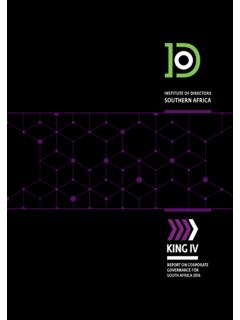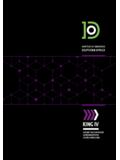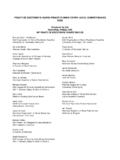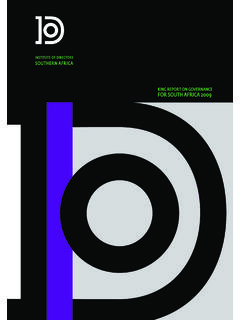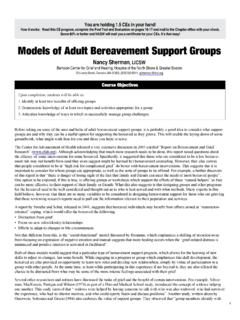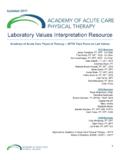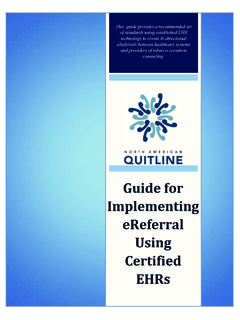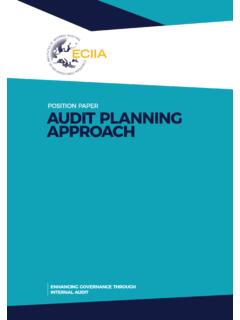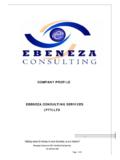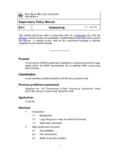Transcription of MANAGING THE OUTSOURCED INTERNAL AUDIT …
1 MANAGING THE OUTSOURCED INTERNAL AUDIT FUNCTIONMANAGING THE OUTSOURCED INTERNAL AUDIT FUNCTION2 Sector: All Economic SectorsFocus: INTERNAL AuditCategory: White PaperIssue Date: October 2013 The information contained in this White Paper is intended to provide the reader with general information and guidance and may not be applicable in all circumstances. The information herein should not be regarded as professional or legal advice or the official opinion of the Institute of INTERNAL Auditors of South Africa (IIA SA).We have taken all reasonable measures to ensure the quality and accuracy of the information. However, no action should be taken on the basis of the information without obtaining professional advice. As such, the IIA SA shall not be held liable for any damage, loss or liability of any nature incurred directly or indirectly by whomever and resulting from any cause in connection with the information contained Through SharingMANAGING THE OUTSOURCED INTERNAL AUDIT FUNCTION3 CONTENTSINTRODUCTION 4 OUTSOURCING THE INTERNAL A UDIT FUNCTION 7 Issues to consider 7 Drafting the contract 8 Address all outsourcing risks 9 CONCLUSION 10 GLOSSARY 11 REFERENCES 11 MANAGING THE OUTSOURCED INTERNAL AUDIT FUNCTION4 According to the King Report on Governance (King III) the board should ensure that there is an effective risk-based INTERNAL It goes further to state in section that the AUDIT committee should be responsible for overseeing INTERNAL AUDIT .
2 Where an organisation chooses to completely outsource this function, King III recommends that a senior executive or director should be responsible for INTERNAL AUDIT , with the responsibility to oversee, manage, inform and take accountability for the effective functioning of the OUTSOURCED INTERNAL AUDIT activity. This responsibility extends to reporting to the AUDIT committee and complying with the independence requirements of an in-house INTERNAL AUDIT function 2 The Institute of INTERNAL Auditors defines INTERNAL auditing as: ..an independent, objective assurance and consulting activity de-signed to add value and improve an organization s operations. It helps an organization accomplish its objectives by bringing a system-atic, disciplined approach to evaluate and improve the effectiveness of risk management, control, and governance processes. 3 INTERNAL auditing is conducted in diverse legal and cultural environments within organizations that vary in purpose, size, complexity, and structure; and by persons within or outside the Despite this diversity, the profession is guided by a common set of professional standards, The International Standards for the Professional Practice of INTERNAL Auditing, issued by the Institute of INTERNAL Auditors (IIA), are regarded as the authoritative source for the practice of INTERNAL auditing 5 These Standards are principle-focused and provide a framework for performing and promoting INTERNAL auditing.
3 The Standards are requirements consisting of: Statements of basic requirements for the professional practice of INTERNAL auditing and for evaluating the effectiveness of its performance. The requirements are internationally applicable at organizational and individual levels. Interpretations, which clarify terms or concepts within the statements. 6 INTRODUCTION Outsourcing: A partnership between a client and an outside vendor, both sharing a common vision to effectively, efficiently and accurately accomplish an agreed-upon process for the benefit of both parties Auditing OUTSOURCED functions - Mark Salamasick 1 King III, : King III, : iKutu Report, : THE OUTSOURCED INTERNAL AUDIT FUNCTION5 Performance Standard 2000 ultimately stipulates that the Chief AUDIT Executive must effectively manage the INTERNAL AUDIT activity to ensure that the results of the INTERNAL AUDIT activity s work achieve the purpose and responsibility included in the INTERNAL AUDIT charter; the INTERNAL AUDIT activity conforms with the Definition of INTERNAL Auditing and the Standards; and the individuals who are part of the INTERNAL AUDIT activity demonstrate conformance with the Code of Ethics and the Standards.
4 7 To achieve the requirements set out in Performance Standard 2000, it is imperative that the INTERNAL AUDIT function be appropriately and sufficiently resourced. The resourcing of the INTERNAL AUDIT function (IAF) can be accomplished in a number of ways. However the INTERNAL AUDIT activity is often best performed by a fully resourced, competent and professional unit INTERNAL to the organisation, and strategically positioned to achieve its objectives. Alternatively, the IAF can be an OUTSOURCED function, or a co-sourced function (a combination of in-house and OUTSOURCED functions ). The latter arrangement allows the in-house IAF to retain responsibility for the INTERNAL AUDIT process, while relying on the external provider for specialised technical skills and enables an organisation to be cost-effective and derive external expertise, while retaining the advantage of direct control over INTERNAL auditing.
5 8 The IIA promotes any INTERNAL AUDIT activity that assists in providing maximum overall effectiveness 9 in the achievement of organisational objectives. In fact, The Standards and Guidelines for the Professional Practice of INTERNAL Auditing, does leave the door open to the possibility of externally provided services, by suggesting that if the INTERNAL AUDIT department does not possess the necessary knowledge, skills, and disciplines necessary to carry out its AUDIT responsibilities, then it is advisable to obtain these from an outside service provider .10 Indeed in practice, increasing organisational and global complexity and rapid technological developments have necessitated that many organisations opt for specialised INTERNAL AUDIT resources as and when required. According to a 2010 study of private and public sector organisations in South Africa, of the respondents indicated that they currently have an in-house INTERNAL AUDIT function while reported that they used OUTSOURCED INTERNAL AUDIT services in the past year to some or other extent.
6 This was broken down as follows: OUTSOURCED the OUTSOURCED the IAFW hile there may be very compelling reasons why a company or organisation may opt for outsourcing, the IIA Global maintains that the oversight and responsibility for INTERNAL AUDIT cannot be OUTSOURCED . 12 After all, corporate governance is a responsibility of the board,13 therefore INTERNAL AUDIT remains the responsibility of the board and the AUDIT committee who must ensure effective oversight of this important function, whether internally or externally provided. Management must set the overall AUDIT strategic direction and ensure the quality of the AUDIT . The caveat, though, is that regardless of who provides the INTERNAL auditing service, it should be performed in conformance with the Standards. 7 iKutu Report, Institute of INTERNAL Auditors (IIA): The role of INTERNAL auditing in resourcing the INTERNAL AUDIT activity , Selim, G.
7 & Yiannakas, A., 2000, Outsourcing the INTERNAL AUDIT Function: A Survey of the UK Public and Private Sectors in International Journal of Auditing, p216 quoted in Yasseen, p2911 Yasseen, Outsourcing the INTERNAL AUDIT Function: A Survey of the South African Public and Private Sectors , University of the Witwatersrand School of Accountancy, 2011, p. 70 - 7112 Institute of INTERNAL Auditors (IIA): The role of INTERNAL auditing in resourcing the INTERNAL AUDIT activity , See King III, THE OUTSOURCED INTERNAL AUDIT FUNCTION6 Given the prevalence of the outsourcing of INTERNAL AUDIT , the purpose of this paper is to provide practical guidance to organisations and oversight bodies on how best to manage the OUTSOURCED function so as to obtain optimum results. The external service provider s performance must be monitored closely to ensure alignment of the organisation s objectives to the IA service the IAF is OUTSOURCED , the person liaising with the external service provider, should ideally be a senior or executive manager assigned the task of MANAGING the INTERNAL AUDIT function.
8 Such an individual should be a dedicated resource, suitably qualified in INTERNAL AUDIT and be accorded a high degree of functional independence within the organisation. Effective project management skills are a must to increase the likelihood of keeping the AUDIT engagement on THE OUTSOURCED INTERNAL AUDIT FUNCTION7 ISSueS to ConSIDerThere are a number of reasons why organisations make the decision to outsource. Most reasons will fall into the categories of cost efficiency; the need for specialised technical expertise; the need to build capacity and to improve the quality of the AUDIT . Once management, together with the oversight body, has made the decision to outsource or co-source INTERNAL AUDIT , then the first important consideration is the assignment of ownership responsibilities within the management structure, followed by documenting these responsibilities in the IA charter.
9 Management, under the oversight of the AUDIT Committee, should then decide the choice of service provider. Such a service provider should ideally be a reputable firm with strong credentials that will meet the needs of the organisation. Here it is important to note that if the INTERNAL AUDIT provider is also the provider of other services to the organisation, notably external AUDIT , there may be a conflict of interest and an objectivity risk that needs to be managed. The notorious Enron case highlights these dangers most starkly, and should serve as a cautionary tale to other organisations that the INTERNAL AUDIT function must be independently executed. The public sector (in terms of the Public Finance Management Act of South Africa - PFMA) goes so far as to prohibit the same firm providing both INTERNAL and external AUDIT services. Where the same firm undertakes both assignments, rigorous vigilance is necessary in monitoring their creating a profile of the ideal service provider firm, it is advisable to draft a checklist from which to gauge their ability to meet the needs of your organisation.
10 OUTSOURCING THE INTERNAL A UDIT FUNCTIONC riteria upon which to evaluate the potential list of service providers: the reputation of the firm provision of a reputable partner who will oversee the IAF and delivery plus support of the client organisation feedback from other clients whether the AUDIT team members are certified in accordance with the IIA SA s career path standards whether the AUDIT team members are members of the IIA SA where they are held accountable against a Code of Ethics the firm s experience in providing the kind of IA services you require an evaluation of the AUDIT team s knowledge, effectiveness, skills sets and expertise usage of appropriate and well researched methodology and related tools availability of personnel involved in conducting and supervising work the costs involved and whether they are likely to escalate if dependency is created quality assurance arrangements whether to use one provider or a panel of providers to acquire all the skills sets required.

